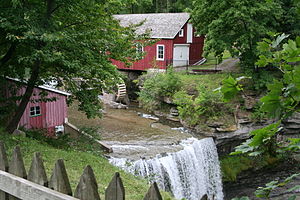The town that would become St. Catharines, Ontario was first mentioned in records under the name St. Catherines in 1796, but it would not be until 1809 that the city’s name would become more standardized with a final “s.”
The town of St. Catharines was originally named after the well-known French saint, Catherine of Alexan, and was located close to Twelve Mile Creek. Before being known as St. Catharines, it was known by a number of names, including Shipman’s Corner (the name and spelling was standardized as St. Catharines). Due to the easy access to water power, it swiftly rose to prominence as a center for industry in the area, which caused a population boom.
There is a lot of debate among academics over the origins of the name Catherine; some claim it is derived from the Latin “Catharina,” while others assert that it has Byzantine roots. The town was founded in the 1700s, and many of its buildings date from earlier times.
This can be seen in the architecture of the buildings as well as in the surnames of the locals, many of which are from this era. One of the most widely accepted ideas holds that it might have originated with Catherine Butler, the wife of Colonel John Butler, and Catherine’s question to Hamilton.
The wife of William Hamilton Merritt, Catharine Rodman Prendergast Merritt, is seen by some to be the source of the spelling change to -ar. It is believed that this alternate spelling of Catharine, with a -er ending rather than the standard -ar ending, was a popular feminine form among Palatine German women at the time. In fact, it was spelled in this way so frequently that some men even adopted it as their surname.
There are many unique neighborhoods in St. Catharines since it has developed over time into a diversified and cohesive town. The present-day downtown core is the only piece of St. Catharines’s original farming settlement that existed in the 1800s; all other land was a part of Grantham Township to the east and Louth Township to the west.
Catharines steadily grew and expanded throughout the late 19th and early 20th centuries. These include the lovely waterfront, the bustling downtown core, and the charming heritage area. Before the turn of the century, St. Catharines’ neighbors to the east and north, as well as Western Hill and Old Glenridge, were all annexed.
The Niagara Mcdonald Conservation Centre, the Lister Block, and the Royal Ontario Museum are just a few of the renowned art institutions located in St. Catharines. the Lister Block, the Niagara Mcdonald Conservation Centre, and the Royal Ontario Museum.
The Brock University’s Rodman Hall Art Centre was established in the former residence of notable local businessman and House of Commons of Canada member Thomas Rodman Merritt. It includes a wide range of artwork, such as works from the CRAM Collective and the Niagara Artists Centre, as well as paintings, sculptures, ceramics, and other media.




